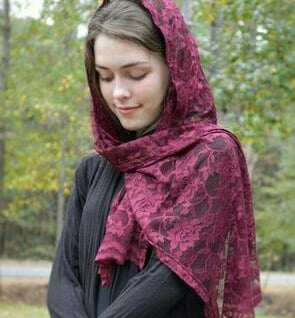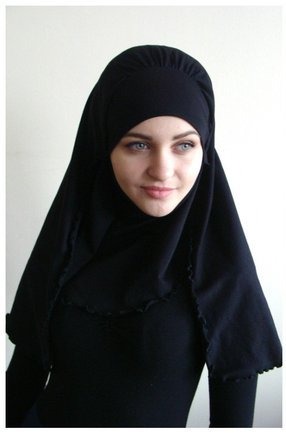Is the Hijab or Head Covering in the Qur'an?
DUTY


The Arabic word 'khumur' (plural of 'khimar') simply means ‘cover’ and has a wide range of meanings.
(24:31) And tell the believing females to lower their gaze and keep covered their private parts, and that they should not reveal their beauty except what is apparent, and let them put forth their covers (khumur / خُمُرْ) over their cleavage (juyoob / جُيُوبِ). And let them not reveal their beauty except to their husbands, or their fathers, or fathers of their husbands, or their sons, or the sons of their husbands, or their brothers, or the sons of their brothers, or the sons of their sisters, or their women, or those maintained by their oaths, or the male servants who are without need, or the child who has not yet understood the composition of women. And let them not strike with their feet in a manner that reveals what they are keeping hidden of their beauty. And repent to God, all of you believers, that you may succeed.
The Arabic word 'khumur' (plural of 'khimar') simply means ‘cover’. It has a wide range of meanings. It may be any cover such as the table napkin. If it is used to cover the head, it will signify the headscarf. However, if the head had been the target, the expression would have been 'khumur-ur-ras' meaning the covering of the head. In the context, one should understand the verse is telling women to cover their cleavage/bosom. Therefore it is the low-necked attire that is meant here. There are many reasons for this:
(1) The Arabic root for the word, shares meanings with more general "covering" or "concealment" and not just headscarf.
(2) The immediate context within the verse, which is ordering the covering of the cleavage only (عَلَى جُيُوبِهِنّ), with no mention of hair (indicating the ordainment is not in the type of apparatus used, but in the covering of low neck-line). Even if it means 'headscarves' worn at the time, the command is not in the type of clothing used to cover the cleavage (headscarf), but to cover the cleavage. The usage of the word is determined by the readily available method at that instance, variable by other means in other parts of the world, or by any means such as a higher neck dress.
(3) It can be observed that men tend to cover all their chest and women reduce their neck-line in society in order to show-off feminine grace. Therefore, in order to tackle the common habit, a commandment to cover the cleavage area is a strong logical reason for the verse than the hair. Therefore, it makes perfect sense to conclude that the intention of "وَلْيَضْرِبْنَ بِخُمُرِهِنَّ عَلَى جُيُوبِهِن / and let them put forth their covers over their cleavage" is to order believing women to ensure the cleavage area is covered and not the hair.
Another important expression mentioned in the verse is the word ‘juyoob’, which means cleavage. This, we believe, is in harmony with the rest of the sentence in which the covering of the low neck is imperative. Moreover, striking of the feet comes next, which might attract attention to the breasts that would be wiggling as a consequence of the striking movement, considering the brassiere did not exist at that time. Then the verse makes an exception for those ornaments that are self-conspicuous. Big breasts cannot be hidden no matter what one does, as a result of physical movements of the body, or may become even more conspicuous when the dress under the effect of a strong wind sticks to the body. So the verse explains this as a natural phenomenon. We read in other verses that women nursed their children up to two years. When her baby cries she may be obliged to nurse it in the presence of her next of kin like her father. This commentary provides us with the necessary elbowroom under the circumstances. One other point that corroborates our argument is the fact that this word makes no allusion to the hanging objects that adorn a woman since the verse also mentions that they can let their ornaments be seen in the presence of women. Dangling ornaments may, of course, be used to show off rather than be an object for seduction. The striking of the feet would not render conspicuous the finery or the jewelry of the woman. Moreover, there is the fact that adornments may be used everywhere. From this it follows that the word ornament is used to refer to the breasts of the woman.
"Do not say falsely, 'this is lawful (halal) and that is prohibited (haram)', inventing a lie about God. Those who invent lies about God do not prosper." (Qur'an 16:116)
The Qur'an reveals that women have been blessed with great beauty, and asks believing women to honour this gift by dressing modestly, ie in a dignified and conscientious manner.
Those that follow the religion of Islam seek to find justifications for their personal agendas and will go to any length to find a Quranic verse they can use to promote their prejudiced views. It is necessary for a true believer to remain sincere and objective, and use an unbiased approach to God's verses to dispel the myths. The Islamists place their man-made religions and the words of their mullahs over that of God's word in the Qur'an. The religion of Islam only keeps people away from reading the Qur'an directly, thinking over it, and surrendering to God.
Concluding, there is no requirement in the Qur'an for women to cover their hair. The Quran says that women should dress modestly. Is the traditional veil seen in many cultures modest? Sure it is, however, to say that the hijab (a religiously-invented piece of clothing that came about after the creation of Islam) is what God is calling for and that any woman who doesn't wear the hijab is somehow sinning or immodest, will not find any support for such claims in the Qur'an. As a sidenote, the hijab and the traditional veil are not necessarily the same thing. The traditional veil is simply laid on the head, such a veil flows naturally and is unrestricted (hair isn't strictly covered completely). We call it the "traditional veil" as it has been seen in cultures native to Europe, Middle East, North Africa, Central and East Asia, etc. The hijab on the other hand is the strict covering of all hair on the head, this type of clothing was not worn before the advent of Islam.
An argument used by many Muslims that push for the hijab on Christians is that Mary, the mother of Jesus, wore the hijab and thus Christian women should too. This is inaccurate as Mary wore the traditional veil, since this was the style of veil worn at the time, as explained earlier, the concept of the hijab did not exist then.


Traditional Veil
Hijab


